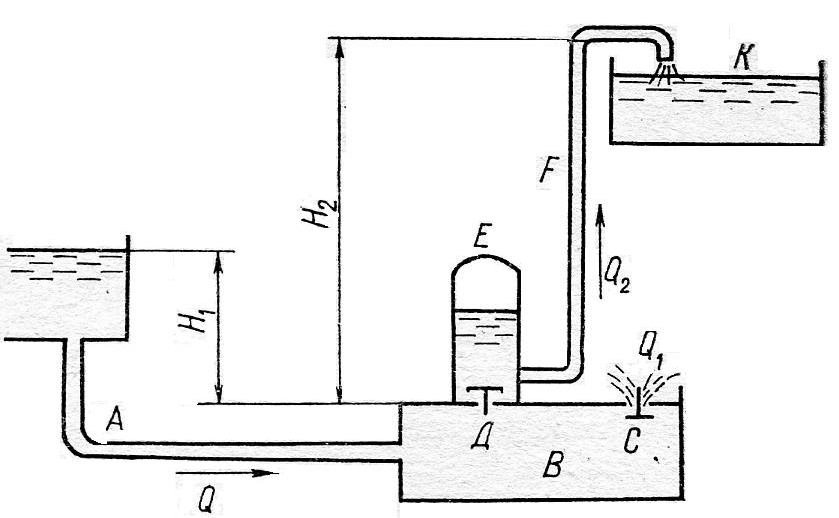ENG | UKR | RUS ||
DonNTU >
Master's portal DonNTU

Ostapchuk Olga
Physical – metallurgical department
Industrial heat energetics faculty
Speciality: Heat energetics
Final work theme:
Energy source working out on the basis of the hydraulic ram
Scientific instruction: Pyathyshkin Geordiy Georgievich
Materials on the final work theme:
About myself | List of literature
- Actuality, scientific significance of the theme and practical value of work results
- A hydraulic ram
- Investigation methods and planned results
1 Actuality, scientific significance of the theme and practical value of work results
Nowadays the need in organic fuel satisfies at the expense of the own extraction on the 44% from the existing consumption level, so it says about the Ukraine belonging to the energo-deficient countries. So it is very important to provide an economic fuel utilization, minimum influence of its burning down on the ecological situation in the country as well. According it I started the investigation about the hydraulic hit and possibilities of its utilization in the energi obtaining, especially a heat. The possibility existance has been proved with conducted experiments, that have been described in the article of V.Maruhin and V.Kut'enkov: “A new source of an unexhausted clean and powerful energi”. It is known that in the technology one can find a device application which allows to use an energy of the hydraulic hit, which is created artificially. The hydraulic ram belongs to such devices, that allows without touch to the mechanical energy current outside to lift a liquid on the necessary height, and a hidroimpulsator that allows to raise a pressure in the hidromonitor stalk at the expense of artifically created ungoing out hydraulic hits (autofluctuation of the pressure) in order to provide a destruction of massifs with a mountainous rocks at the hidromonitoring way of minerals extraction (mining). At this moment one can get a pulsing water jet.
So, the investigation actuality of the hidraulic hit as an energy source consists of an idea that the worked-out device on its base can work without fuel burning or big electroenergy expenditures, and it will be symple in the exploitation and on the construction as well.
2 A gist of a gidraulic hit
A hydraulic hit – is a phenomenon of a abrupt pressure changing in the moving liquid, that is limited with a solid walls, at the considerable changing of its speed during a short time interval. Causes of the hydraulic hit beginning may be different, such as quick closing or opening a locked and regulating devices, a sudden stop of pumps, an air release through the hydrants on the irrigating set, at the fulling of the pipelines with a water (as usually a hydraulic hit can begin in the final stage of the air release), pump setting in motion at the open breech-block on the force line.
A hydraulic hit appears quite well at the abrupt closing of the bolt in the pipeline end. Pressure increase can be very considerable and results in a serious accidents in the system.
Theoretical and experimental investigations of the hydraulic hit in pipes were first done by the professor N.E.Zhykovskiy, who proved that the hydraulic hit is the quickproceeding wave process in this work ‘About hydraulic hit in the water pipelines” (1899). A character of this process depends on the liquid compressing and pipeline walls elasticity and consists of a pressure hesitations.
A quantity of the pressure hit  one can find on the formula of N.E.Zhukowskiy:
one can find on the formula of N.E.Zhukowskiy:
 (2.3)
(2.3)
where  ;
;
E – is a module of a volume liquid elasticity, Pa;
 - is a normal voltage in a pipe walls material;
- is a normal voltage in a pipe walls material;
 - is a thickness of a pipe walls.
- is a thickness of a pipe walls.
In the expression (2.3) ) it is a movement speed of the hit wave in a pipe. At is :
 (2.4)
(2.4)
At the  we find that
we find that  , , that corresponds to the sound speed c in a liquid. A quantity a differs the c on the quantity of a correcting coefficient, accounting the influence of the pipewalls elasticity on the sound speed.
, , that corresponds to the sound speed c in a liquid. A quantity a differs the c on the quantity of a correcting coefficient, accounting the influence of the pipewalls elasticity on the sound speed.
We will write down the Zhukowskiy formula as a:
 (2.5)
(2.5)
This formula is correct if a bolt absolutely shuts a pipe off. If this closing is not enough, and as a result a speed decreases from the beginning meaning  to the final one
to the final one  , so Zhukowskiy formula can be written as:
, so Zhukowskiy formula can be written as:
 (2.6)
(2.6)
It is quite correct for the straight hydraulic hit as well. For unstraight hydraulic hit the quantity  is determined approximately on the formula:
is determined approximately on the formula:
 (2.7)
(2.7)
If it is  , so it is
, so it is  , it means that hydro-hit will be not. So, one of the main way of a fight with a hydraulic hit is a slow pipes Shutting off. If it is impossible so pneumatic cap is set near the bolt. An air volume of the pneumo-cap slows a liquid braking process down, that is equivalently to a time increasing of the bolt closing.
, it means that hydro-hit will be not. So, one of the main way of a fight with a hydraulic hit is a slow pipes Shutting off. If it is impossible so pneumatic cap is set near the bolt. An air volume of the pneumo-cap slows a liquid braking process down, that is equivalently to a time increasing of the bolt closing.
Åùå îäíèì ñïîñîáîì áîðüáû ñ ãèäðîóäàðîì ÿâëÿåòñÿ One more method as to the fight with a hydro-hit is a utilization of the anti-hit throwing valves near the bolt which are opening when it is a pressure increase in the pipe and throw a part of liquid off that allows to decrease a pressure.
3 A hydraulic ram
As we noticed at the beginning, a phenomenon of the hydraulic hit can be used for the water listing with a special device, named as a hydraulic ram. Its scheme is done on the page 3.1.

A picture 3.1 – The Hydraulic Ram Scheme
A hydraulic ram consists of a bringing pipeline A, as usually it has not very long length, then a working box B with two valves C and D, andan aircap E with a forcing pipeline F, which brings a water into the reservoir K. A hitting valve C opens under own weight. During its opening a weter begins to go through the brought pipeline A under the not big force H1, which flows from the open valve C out. In the consequence of the increasing of an influence force of the flowing water with an increasing speed or a hitting valve, the late is closing and a current speed in the pipeline is falling up to zero. In the connection with a sudden current stop in the brought pipeline and working box there will be a hydraulic hit an abrupt pressure increase. As a result of such pressure the forcing valve is opening, and the part of water will flow into the air cap E, pressing a present air there, which will force out a part of weter into the forced pipeline F, risen it on the height H2 into the reservoir K. When some part of water will flow out into the air-cap, the pressure in the working box will be decreased and forced valve C will be opened with the aid of own weight. In this time the water begins to flow out through the valve C again, but a forcing valve D will be closed under the action of air pressure power in the air-cap E. Then this process repeats itself…
So everytime such processrepeats. Water exprenditure Q has been spent mainly for the water pouring out Q1 through the valve C and pressure creation on this valve which will be closed in such condition, the first work period of the hydraulic ram is called a dispersed period.
4 Investigation methods and planned results
At is plaaned to do an investigation of the liquid state in the pipe at the artificially created hydraulic hit. The calculated scheme will consist of modified module of the hydraulic ram. In the process of investigation there will be considered an equalization of moment and an equalization of energy that allows to get a data about speed and temperature of the liquid in every point of the scheme.
Investigation method will be chosed from numeral methods. There are two big groups – polystepped different methods and Runge-Kytt methods. The main idea Runge-Kytt methods is that derivatives approximate through the function meanings  in points on the interval
in points on the interval  , which will be chosed from the condition of a maximum proximity of the algorithm to the Taylor line.
, which will be chosed from the condition of a maximum proximity of the algorithm to the Taylor line.
DonNTU >
Master's portal DonNTU ||
About myself | List of literature
 one can find on the formula of N.E.Zhukowskiy:
one can find on the formula of N.E.Zhukowskiy: (2.3)
(2.3) ;
; - is a normal voltage in a pipe walls material;
- is a normal voltage in a pipe walls material; - is a thickness of a pipe walls.
- is a thickness of a pipe walls. (2.4)
(2.4) we find that
we find that  , , that corresponds to the sound speed c in a liquid. A quantity a differs the c on the quantity of a correcting coefficient, accounting the influence of the pipewalls elasticity on the sound speed.
, , that corresponds to the sound speed c in a liquid. A quantity a differs the c on the quantity of a correcting coefficient, accounting the influence of the pipewalls elasticity on the sound speed.  (2.5)
(2.5) to the final one
to the final one  , so Zhukowskiy formula can be written as:
, so Zhukowskiy formula can be written as: (2.6)
(2.6) is determined approximately on the formula:
is determined approximately on the formula: (2.7)
(2.7) , so it is
, so it is  , it means that hydro-hit will be not. So, one of the main way of a fight with a hydraulic hit is a slow pipes Shutting off. If it is impossible so pneumatic cap is set near the bolt. An air volume of the pneumo-cap slows a liquid braking process down, that is equivalently to a time increasing of the bolt closing.
, it means that hydro-hit will be not. So, one of the main way of a fight with a hydraulic hit is a slow pipes Shutting off. If it is impossible so pneumatic cap is set near the bolt. An air volume of the pneumo-cap slows a liquid braking process down, that is equivalently to a time increasing of the bolt closing.

 in points on the interval
in points on the interval  , which will be chosed from the condition of a maximum proximity of the algorithm to the Taylor line.
, which will be chosed from the condition of a maximum proximity of the algorithm to the Taylor line.